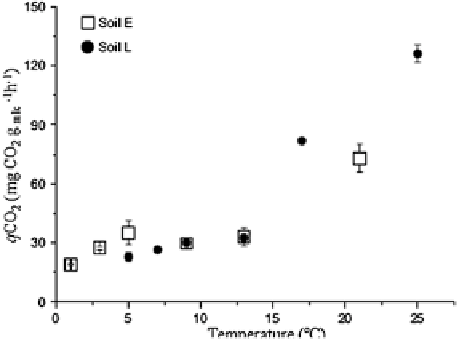Environmental Engineering Reference
In-Depth Information
patterns, availability of microorganisms) factors (Mostofa et al.
2009a
; Malcolm
1985
; Wetzel
1992
; Nakane et al.
1997
; Uchida et al.
1998
,
2000
). Soil OM is
typically lost upon agricultural conversion that reduces plant residue inputs,
tillage-induced soil disturbance, erosion, and by the creation of more favora-
ble conditions for microbial decomposition (Robertson and Grace
2004
). The
growth of typical terrestrial vegetation, rainforest, vascular plants and/or typical
grassland and their degradation are significantly higher during the warm sea-
sons than in the cold ones, because increased temperature would enhance respi-
ration and decomposition in the soil environment (Nakane et al.
1997
; Uchida
et al.
1998
,
2000
; Duff et al.
1999
; Fahey et al.
2005
). The temperature increase
is often found to enhance the soil CO
2
fluxes to the atmosphere (Fig.
3
) (Feng
and Simpson
2009
).
However, the enhanced plant or litter inputs induced by warming have a
stronger control on soil microbial responses than the temperature increase itself.
Therefore, it is suggested that the quality of soil organic matter can control micro-
bial responses to global warming (Feng and Simpson
2009
; Rinnan et al.
2008
;
Zhang et al.
2005
). The temperature effects outlined above may be comparatively
less important at temperate latitudes, because the soil respiration rate is highly
increased by temperature in areas where the soil temperatures are low (Lloyd and
Taylor
1994
; Biasi et al.
2005
).
Warming might affect the abundance of soil microorganisms, but contrasting
data are presently available. A 20-60 % increase in the fungal:bacterial ratio has
been observed in a tallgrass prairie site, exposed to a ~2 ºC increase in temperature
over a three-year period (Zhang et al.
2005
), but another study has shown that the
relative abundance of fungi was significantly reduced after 15 years of soil warm-
ing (1-2 ºC) in northern Sweden (Rinnan et al.
2008
).
The global warming effect might be significantly different depending on the
soil ecosystems. Indeed, changes in soil respiration and CO
2
fluxes are the effects
of temperature and vegetation differences (Table
1
) (IPCC
2001
; Trumbore
Fig. 3
Metabolic quotient
(
q
CO
2
) of both grassland
soils on Day 1. Points show
average values of triplicate
(n
=
3) and error bars
represent standard error. Soil
E and soil L are the two soil
samples collected from the
two different sites in Alberta,
Canada.
Data source
Feng
and Simpson (
2009
)

